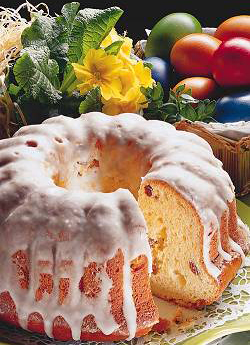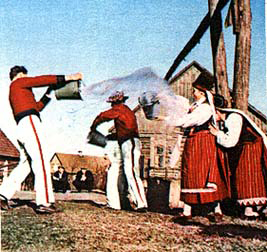Easter – Wielkanoc Posted by Anna on Apr 3, 2010 in Culture
Anna’s comment –
I asked Adam to write about Easter knowing full well that he would be reluctant to do so. And also knowing full well that he would object to the idea that being Polish equals being Catholic. But unfortunately, for what it’s worth, Poland is perceived as a Catholic country, and Easter is a religious holiday. An important one, at that.So here is Adam’s Easter write-up:
As this is the time of Easter I was asked to write about Polish traditions connected with this specific holiday. I do have some mixed feelings writing about this topic. First of all, I do not feel that religion should be connected with nationality, and I don’t see Catholic religious rituals as something specifically connected with being Polish. As Polish people do also come as atheists and followers of other faiths. Although Catholic rituals in Poland sometimes seem removed from their religious roots and appear nothing more but as simply – traditions. And this is probably the most popular approach.
First Easterish celebrations begin one week before Easter – on Palm Sunday (niedziela palmowa). On this day people bring decorative “palms” to church to get them sprinkled with Holy Water, which surely has some deep religious meaning. In many villages there are special competitions for the biggest or most beautiful “palm”. Those palms are then taken back home, and kept as Easter decorations.
Proper Easter begins in Poland on Holy Saturday (Wielka Sobota, literally Great Saturday). This is the day of preparations. Easter is not Easter without certain props – that are connected with spring, and everything waking up and refreshing. These props are of course eggs (jaja, jajka), but also bunnies, chickens. Many people arrange tree branches with fresh pussy willows (bazie) in a vase. Eggs need to be colored and turned into pisanki. There are many different ways of doing it, and it’s usually a fun activity for kids. In some regions people simply boil eggs with onions, beets or other natural ingredients – which turn the eggshells red. Some people first use melted wax to create patterns on eggs, and then dip them in color. All painted (waxed over) areas are then white. Some people cut small patterns in paper and stick them to eggs. Others prefer to empty the egg, and make a wydmuszka. They pierce a little hole with a needle at the top and bottom of an egg and then blow air inside and the insides of the egg come out through the hole. And then color the shell.
When the eggs are ready, people put them together with a piece of white sausage (biała kiełbasa), a bit of salt, some bread into a specially decorated little basket. This basket (święconka) is then taken to church on Holy Saturday and after some religious abracadabra its contents are all ready for use on Sunday.
Sunday breakfast is the crucial point of Polish Easter. Before the breakfast eggs from the basket are cut and people at the table share them giving good wishes to everyone there. Traditional Easter breakfast consists of żurek (soup made from fermented flour), boiled white sausage, pates, eggs in many forms and cakes (like baba drożdżowa – lit. yeasty peasant woman, name comes from a traditional holiday folk dress peasant women used to wear, which this cake resembles in shape.
Celebrations continue on Easter Monday (lany poniedziałek), called in Polish śmigus dyngus or śmingus dyngus. It’s a day when people try to splash one another (by sometimes very nasty surprise, of course) with water. It is said to bring good luck. It comes from peasant traditions, when back in the olden days usually single young men splashed young single girls. Today everyone splashes everyone, and the young ones are most engaged in this process. It is advised to stay at home on this day, as it is possible that hoards of youngsters will get you and soak you wet with buckets of water. This is śmigus dyngus taken to extreme.
Some people prefer to be exempt from all the Easter hassle and travel for the long weekend break:)
Tak czy owak Polski Blog życzy Wam wesołych świąt i smacznego jajka
Anyway Polish Blog wishes you happy holidays and tasty eggs (that’s what people do wish one another in Poland).

Build vocabulary, practice pronunciation, and more with Transparent Language Online. Available anytime, anywhere, on any device.





